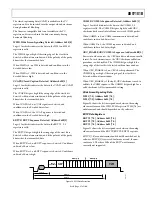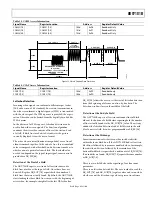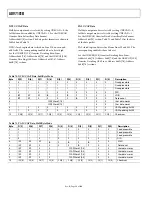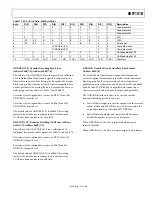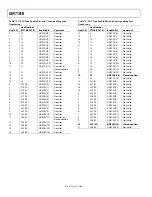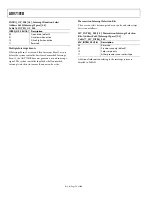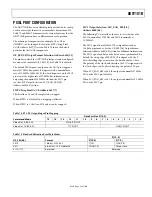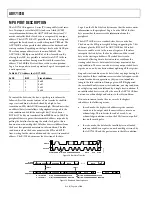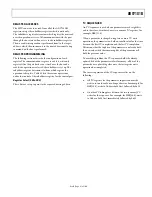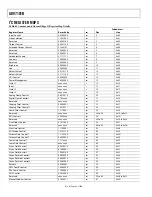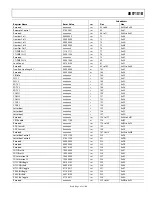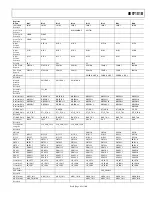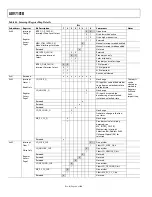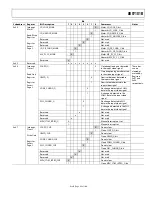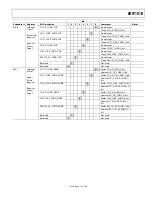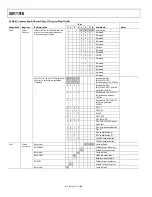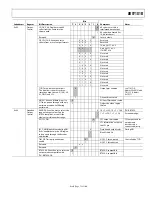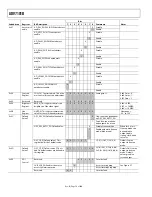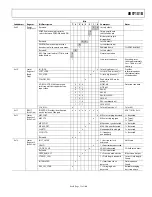
ADV7181B
Rev. B | Page 60 of 100
MPU PORT DESCRIPTION
The ADV7181B supports a 2-wire (I
2
C-compatible) serial inter-
face. Two inputs, serial data (SDA) and serial clock (SCLK),
carry information between the ADV7181B and the system I
2
C
master controller. Each slave device is recognized by a unique
address. The ADV7181B’s I
2
C port allows the user to set up and
configure the decoder and to read back captured VBI data. The
ADV7181B has four possible slave addresses for both read and
write operations, depending on the logic level on the ALSB pin.
These four unique addresses are shown in Table 80. The
ADV7181B’s ALSB pin controls Bit 1 of the slave address. By
altering the ALSB, it is possible to control two ADV7181Bs in
an application without having a conflict with the same slave
address. The LSB (Bit 0) sets either a read or write operation.
Logic 1 corresponds to a read operation; Logic 0 corresponds to
a write operation.
Table 80. I
2
C Address for ADV7181B
ALSB R/W
Slave
Address
0 0
0x40
0 1
0x41
1 0
0x42
1 1
0x43
To control the device on the bus, a specific protocol must be
followed. First, the master initiates a data transfer by establish-
ing a start condition, which is defined by a high-to-low
transition on SDA while SCLK remains high. This indicates that
an address/data stream follows. All peripherals respond to the
start condition and shift the next eight bits (7-bit a
R/W bit). The bits are transferred from MSB down to LSB. The
peripheral that recognizes the transmitted address responds by
pulling the data line low during the ninth clock pulse; this is
known as an acknowledge bit. All other devices withdraw from
the bus at this point and maintain an idle condition. The idle
condition is where the device monitors the SDA and SCLK
lines, waiting for the start condition and the correct transmitted
address. The R/W bit determines the direction of the data.
Logic 0 on the LSB of the first byte means that the master writes
information to the peripheral. Logic 1 on the LSB of the first
byte means that the master reads information from the
peripheral.
The ADV7181B acts as a standard slave device on the bus.
The data on the SDA pin is eight bits long, supporting the 7-bit
addresses plus the R/W bit. The ADV7181B has 249 subad-
dresses to enable access to the internal registers. It therefore
interprets the first byte as the device address and the second
byte as the starting subaddress. The subaddresses auto-
increment, allowing data to be written to or read from the
starting subaddress. A data transfer is always terminated by a
stop condition. The user can also access any unique subaddress
register on a one-by-one basis without updating all the registers.
Stop and start conditions can be detected at any stage during the
data transfer. If these conditions are asserted out of sequence with
normal read and write operations, they cause an immediate
jump to the idle condition. During a given SCLK high period,
the user should only issue one start condition, one stop condition,
or a single stop condition followed by a single start condition. If
an invalid subaddress is issued by the user, the ADV7181B does
not issue an acknowledge and returns to the idle condition.
If in auto-increment mode the user exceeds the highest
subaddress, the following occurs:
•
In read mode, the highest subaddress register contents
continue to be output until the master device issues a no
acknowledge. This indicates the end of a read. A no
acknowledge condition is when the SDA line is not pulled
low on the ninth pulse.
•
In write mode, the data for the invalid byte is not loaded
into any subaddress register, a no acknowledge is issued by
the ADV7181B, and the part returns to the idle condition.
SDATA
SCLOCK
START ADDR
ACK
ACK
DATA
ACK
STOP
SUBADDRESS
1–7
1–7
8
9
8
9
1–7
8
9
S
P
R/W
04984-038
Figure 38. Bus Data Transfer
S
WRITE
SEQUENCE
SLAVE ADDR
A(S)
SUB ADDR
A(S)
DATA
A(S)
DATA
A(S)
P
S
READ
SEQUENCE
SLAVE ADDR
SLAVE ADDR
A(S)
SUB ADDR
A(S) S
A(S)
DATA
A(M)
DATA
A(M) P
S = START BIT
P = STOP BIT
A(S) = ACKNOWLEDGE BY SLAVE
A(M) = ACKNOWLEDGE BY MASTER
A(S) = NO-ACKNOWLEDGE BY SLAVE
A(M) = NO-ACKNOWLEDGE BY MASTER
LSB = 1
LSB = 0
04984-039
Figure 39. Read and Write Sequence


